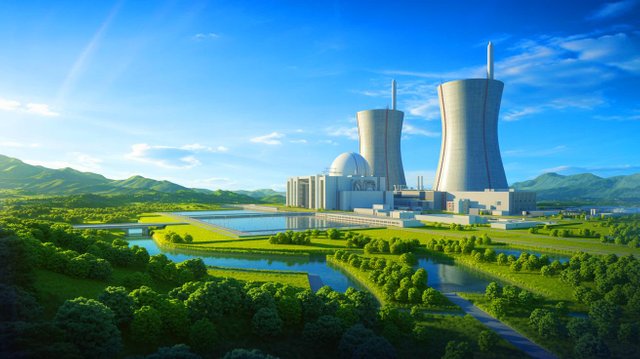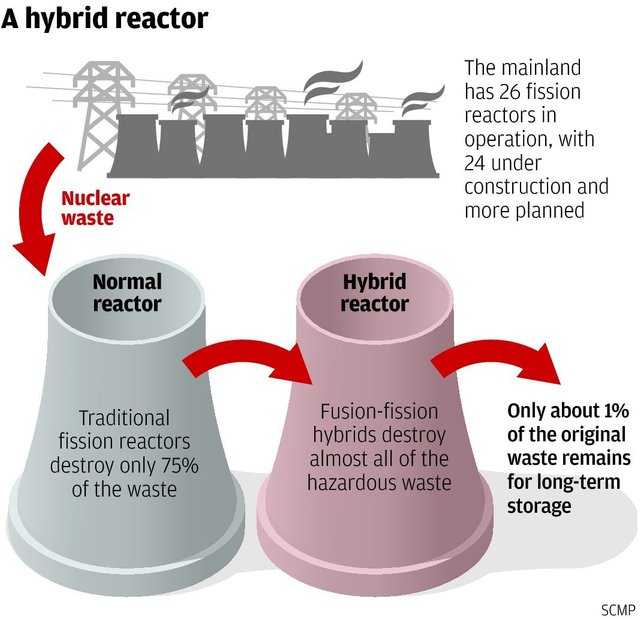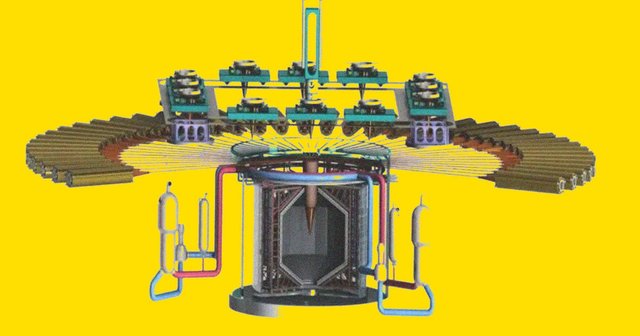China will create the first hybrid fusion-fission reactor/China creará el primer reactor híbrido de fusión-fisión

Source
As you all know, nuclear fusion is the energy that makes the stars, for a few decades the human being has been trying to emulate the functioning of the stars on the earth, with international draft projects such as the ITER. The fact is that, every time that the experts in fusion are asked when we can enjoy this energy at the commercial level, they always answer that "in the next twenty years" without visible results. But now it seems that China has found a shortcut and promises to make it work in ten years.
Como todos sabéis, la fusión nuclear es la energía que hace existir a las estrellas, desde hace unas cuantas décadas el ser humano lleva intentando emular el funcionamiento de las estrellas en la Tierra, con proyectos de calado internacional como el ITER. El caso es que, siempre que se pregunta a los expertos en fusión cuando podremos disfrutar de esta energía a nivel comercial, siempre responden que "en los próximos veinte años" sin resultados visibles. Pero ahora parece que china ha encontrado un atajo y promete hacerlo funcionar en diez años.
China is developing the hybrid fusion-fission reactor Xinghuo, an innovative project that wants to combine the advantages of both nuclear processes, fusion and fission, to generate electricity more efficiently, stable and sustainable than traditional reactors. To operate this hybrid reactor, a fusion reaction is produced in the reactor core, where light nuclei (such as deuterium and tritium) combine to form a heavier nucleus, releasing a large amount of energy, especially high energy neutrons.
China está desarrollando el reactor híbrido de fusión-fisión Xinghuo, un proyecto innovador que quiere combinar las ventajas de ambos procesos nucleares, fusión y fisión, para generar electricidad de manera más eficiente, estable y sostenible que los reactores tradicionales. Para hacer funcionar este reactor híbrido se produce una reacción de fusión en el núcleo del reactor, donde núcleos ligeros (como deuterio y tritio) se combinan para formar un núcleo más pesado, liberando una gran cantidad de energía, especialmente, neutrones de alta energía.

Source
These high energy neutrons produced are not used directly to generate electricity, but are impacting on a "blanket" of materials, such as uranium-238 or thorium, which surrounds the fusion reactor. Upon receiving neutrons, these materials are transformed into fuel fuels (such as plutonium-239), which in turn can also produce a fission reaction, releasing even more energy and producing electricity continuously. The process allows to "manufacture" nuclear fuel while generating energy, optimizing the use of materials and reducing the quantity and danger of long -lived radioactive waste.
Estos neutrones de alta energía producicos no se usan directamente para generar electricidad, sino que se les hace impactar sobre un "manto" de materiales, como uranio-238 o torio, que rodea el reactor de fusión. Al recibir los neutrones, estos materiales se transforman en combustibles fisionables (como plutonio-239), que a su vez también pueden producir una reacción de fisión, liberando aún más energía y produciendo electricidad de forma continua. El proceso permite "fabricar" combustible nuclear mientras se genera energía, optimizando el uso de materiales y reduciendo la cantidad y peligrosidad de los residuos radiactivos de larga vida.
This hybrid system can maintain a constant electricity flow, avoiding the fluctuations that can occur in pure fusion reactors. The objective is to achieve a factor of energy gain (Q) greater than 30, which means that the energy produced will be 30 times greater than that consumed and is what experts consider necessary for a fusion plant to be commercially profitable. This Q of 30 widely exceeds the values of current international projects such as ITER that are satisfied with a Q equal to 10.
Este sistema híbrido puede mantener un flujo de electricidad constante, evitando las fluctuaciones que pueden ocurrir en reactores de fusión pura. El objetivo es alcanzar un factor de ganancia energética (Q) superior a 30, lo que significa que la energía producida será 30 veces mayor que la consumida y es lo que los expertos consideran necesario para que una planta de fusión sea comercialmente rentable. Este Q de 30 supera ampliamente los valores de proyectos actuales internacionales como ITER que se dan por satisfechos con un Q igual a 10.

Source
The project is called Xinghuo and means "spark" and that it seems is inspired by a Mao appointment: "A single spark can set on fire the entire meadow." The hybrid reactor will be located in Yaohu Science Island in the province of Jiangxi. It is planned to develop a 100 MW power of continuous electricity. The project will have an estimated investment of more than 2.7 billion dollars and hope to have it in operation between 2030 and 2035, much earlier what other ongoing fusion projects promise.
El proyecto recibe el nombre de Xinghuo significa "chispa" y que según parece está inspirado en una cita de Mao: "una sola chispa puede incendiar toda la pradera". El reactor híbrido estará ubicado en Yaohu Science Island en la provincia de Jiangxi. Está previsto que desarrolle una potencia de 100 MW de electricidad continuos. El proyecto tendrá una inversión estimada de más de 2.700 millones de dólares y esperan tenerlo en funcionamiento entre 2030 y 2035, mucho antes lo lo que prometen otros proyectos de fusión en curso.
By transforming fertile materials into useful fuels and making better use of waste, the environmental impact is minimized and the nuclear fuel cycle is optimized. With this hybrid fusion-fission reactor China seeks to take advantage of both nuclear worlds to produce clean, continuous and less waste energy. If they get it, there is no doubt that this could mark a before and after in the global energy industry if it demonstrates its technical and economic viability.
Al transformar materiales fértiles en combustibles útiles y aprovechar mejor los residuos, se minimiza el impacto ambiental y se optimiza el ciclo del combustible nuclear. Con este reactor híbrido de fusión-fisión China busca aprovechar lo mejor de ambos mundos nucleares para producir energía limpia, continua y con menos residuos. Si lo llegan a conseguir, no cabe duda de que esto podría marcar un antes y un después en la industria energética global si demuestra su viabilidad técnica y económica.
More information/Más información
https://www.sustainability-times.com/energy/china-moves-decades-ahead-worlds-first-fusion-fission-hybrid-reactor-set-to-eclipse-u-s-efforts-by-2030/
Con China no se sabe que puede salir mal, así como en Wuhan cuando desató la COVID 19 con graves consecuencia para el resto del mundo, porque ellos siguen creciendo, incluso en pandemia.
Gracias por tu interesante reseña. Saludos..!